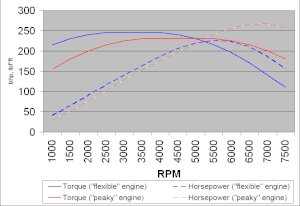
Back Courbe de puissance moteur French Curva motore Italian Powerband Dutch Швидкісна характеристика двигуна Ukrainian
This article needs additional citations for verification. (May 2024) |


A) intake (4T); piston return to TDC (2T)
B) compression (4T); piston descent at PMI (2T)
C) expansion
D) exhaust
α) time average engine
The power band of an internal combustion engine or electric motor is the range of operating speeds under which the engine or motor is able to output the most power, that is, the maximum energy per unit of time. This usually means that maximum acceleration can be achieved inside this band (often at the cost of lower efficiency). While engines and motors have a large range of operating speeds, the power band is usually a much smaller range of engine speed, only half or less of the total engine speed range[1] (electric motors are an exception—see the section on electric motors below).
Specifically, power band is the range of RPM around peak power output. The power band of an internal combustion gasoline automobile engine typically starts at midrange engine speeds (around 4,000 RPM) where maximum torque is produced, and ends below the redline after reaching maximum power (above 5,000 RPM but less than 7,000 RPM). Diesel engines in cars and small trucks may develop maximum torque below 2,000 RPM with the power peak below 5,000 RPM.
- ^ "Torque and BHP explained". Alex Muir. Retrieved 15 May 2024.
© MMXXIII Rich X Search. We shall prevail. All rights reserved. Rich X Search